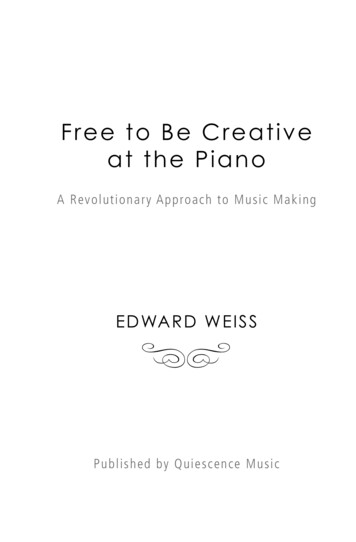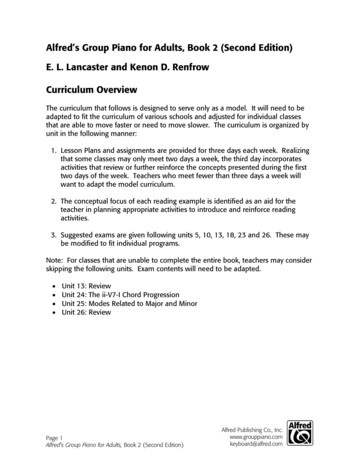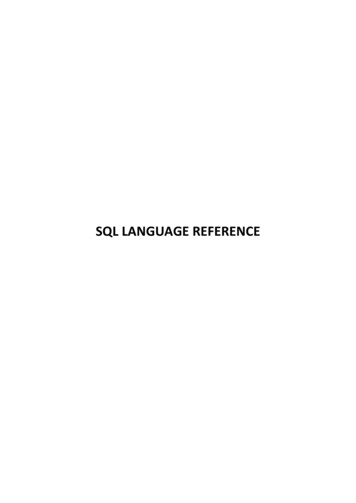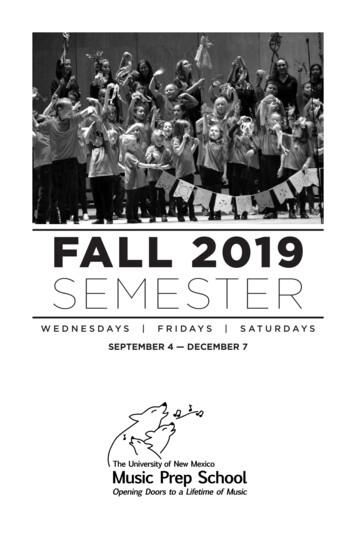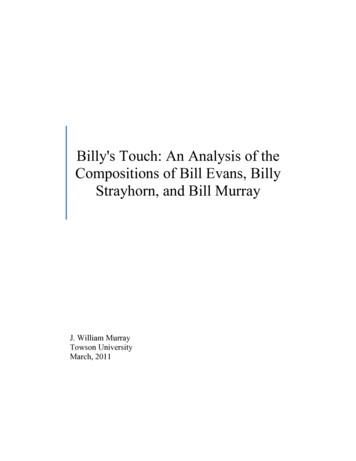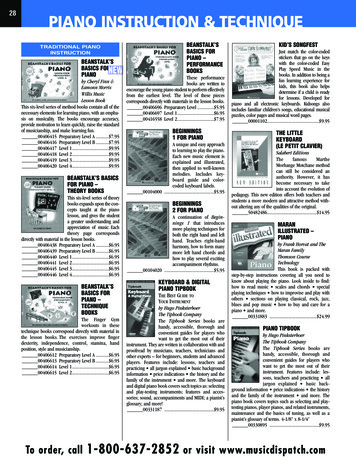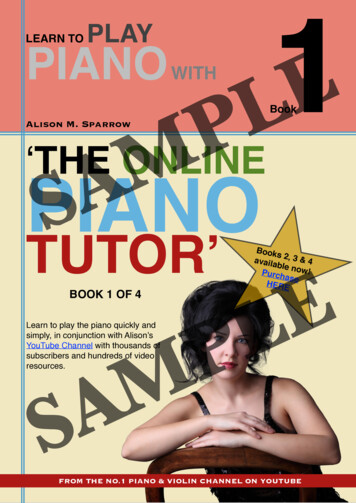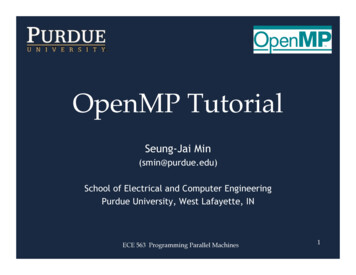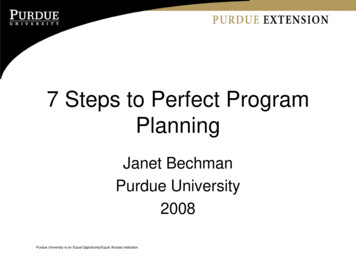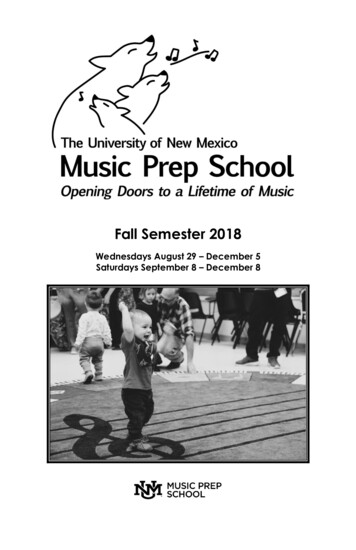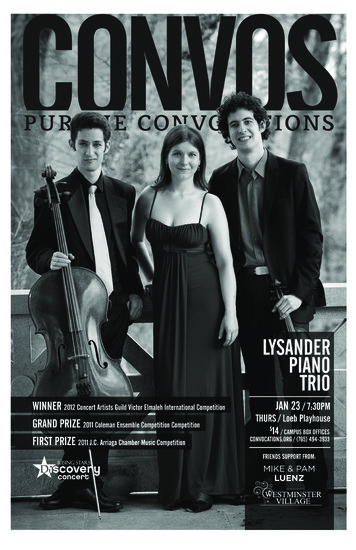
Transcription
LYSANDER PIANO TRIOJanuary 23, 2014 / 7:30 PM / Loeb PlayhouseItamar Zorman, violinMichael Katz, celloLiza Stepanova, pianoJOAQUÍN TURINA(1882-1949)Circulo, Op. 91 (The Circle)Amanecer (Dawn)Mediodía (Midday)Crepúsculo (Dusk)WOLFGANG AMADEUS MOZART(1756-1791)Piano Trio in C Major, K. 548AllegroAndante cantabileAllegrettoPAUL BEN-HAIM(1897-1984)Variations on a Hebrew Melody (1939)INTERMISSIONMAURICE RAVEL(1875-1937)Piano Trio in A minorModéréPantoum: Assez vifPassacaille: Très largeFinale: AniméASTOR PIAZZOLLA(1921-1992)Cuatro Estaciones Porteñas(The Four Seasons of Buenos Aires - Excerpts)Otoño Porteño (Autumn in Buenos Aires)Primavera Porteña (Spring in Buenos Aires)Program subject to changeLysander Piano Trio is a winner of the 2012 Concert Artists Guild International Competition.Lysander Piano Trio is represented by:Concert Artists Guild--850 Seventh Ave, PH-A, New York, NY 10019www.lysandertrio.comwww.concertartists.org
ABOUT LYSANDER PIANO TRIOThe Lysander Piano Trio is a winner of the 2012 Concert ArtistsGuild Victor Elmaleh International Competition where it wasfurther distinguished as the Chamber Music America ShowcasePerformance recipient. Jennifer Bilfield, President and CEOof Washington Performing Arts Society and a member of thejury for the Final Round of the CAG Competition, describes theensemble as bringing an “informed, energized musical personalityto its performances.” These qualities have made the Trio animmediate standout at other competitions, and its prior awardsinclude top honors at the 2010 Fischoff National Chamber MusicCompetition, the 2011 Coleman Chamber Ensemble Competition(Grand Prize) and the 2011 J. C. Arriaga Chamber MusicCompetition (First Prize).The 2013-14 season is an auspicious one for the Lysander Trio,featuring three prominent concerts in New York City: WeillRecital Hall at Carnegie Hall (CAG New York Series); SchneiderConcerts Chamber Music Series at the New School; and MerkinConcert Hall (Tuesday Matinee Series). Other season highlightsin North America include: Purdue University’s ConvocationsSeries; UCLA’s Clark Memorial Library, Rockford CoronadoConcerts near Chicago, Smith College (MA), Sheldon Friends ofChamber Music (Lincoln, NE) and the Rhinebeck Chamber MusicSociety in upstate New York.Only two months after its founding in 2009, while the playerswere graduate students at The Juilliard School, the Trio wasselected to represent Juilliard in a special concert in MexicoCity on the occasion of President Joseph Polisi’s visit to Mexico.In that relatively short time, the ensemble has already enjoyedperformances at Lincoln Center’s Alice Tully Hall and DavidRubenstein Atrium, Merkin Concert Hall, Weill Recital Hall atCarnegie Hall and the Terrace Theater at Kennedy Center inWashington, DC. Other recent performances include concerts atthe Harvard Club, Jewish Theological Seminary and the BrunoWalter Auditorium of the New York Public Library, Connecticut’sTreetops Chamber Music Society and Elmira College in upstateNew York.
The Lysander Piano Trio has performed in master classes forAlfred Brendel and for Ida and Ani Kavafian at the ChamberMusic Society of Lincoln Center, and it has studied with RonaldCopes of the Juilliard String Quartet, Joseph Kalichstein ofthe Kalichstein-Laredo-Robinson Trio and Seymour Lipkin.The Lysander Trio takes its name from the character inShakespeare’s A Midsummer Night’s Dream.PROGRAM NOTESCirculo, Op. 91JoaquínTurina (1882-1949)A fantasy in three movements on the progress of a single day,Turina’s Circulo starts at dawn (Amanecer), and continues throughmidday (Mediodía), to dusk (Crepúsculo). The music indeed startsin the dark, with the murmuring low notes of the cello, and gainsmore and more momentum both dynamically and rhythmically untila big arrival in C Major, which could be interpreted as sunrise. Asis typical of Turina’s style, the melodies and rhythms have a verydistinctly Spanish flavor, and the opening of the second movementhas the strings play chords Pizzicato, imitating the guitar. Thepace keeps accelerating, and reaches its peak in the beginning ofthe last movement, a thrilling dance in three. From there on, themusic calms down as the day comes to a close, and gradually we findourselves again in the dark, where the music of the first movementcomes back. It joins motives from the other movements, to reflectand conclude the adventures of the day.Itamar Zorman, Lysander Piano TrioPiano Trio in C Major, K. 548Wolfgang Amadeus Mozart (1756-1791)As Haydn forged the Classical period and Beethoven pushed ittowards Romanticism, Mozart consolidated it in a way unmatchedby any other composer. To it he brought not only the elegance andgrace we associate with the earlier Baroque period, but also thebrilliance, power, and clarity that define the Classical period. So,too, was Mozart a harmonic and melodic innovator. His death atthirty-five has left us with endless unanswered questions of wherehe would have taken his profound effect on Western music. Despite
the brevity of his life, he produced a catalogue of works that definedopera, the Mass, the symphony, the piano concerto, and the pianosonata. To chamber music he brought his rich array of duo sonatas,string quartets, string quintets, and piano trios that never dull intheir many performances. Those who play his music will quicklyattest to its singular virtuosic challenges based on a demand forabsolute clarity.On the death of the American novelist Saul Bellow in 2005, TheNew York Times wrote that Mr. Bellow once told a reporter that“for many years, Mozart was a kind of idol to me—this rapturoussinging that’s always on the edge of sadness and melancholy anddisappointment and heartbreak, but always ready for an outburst ofthe most delicious music.” That statement beautifully portrays themusic of Mozart and, specifically, the C Major Piano Trio.Sometimes mistaken as a simple piece, the C Major Piano Triois far from that. First of all, it was written just three years shortof Mozart’s death, and, secondly, during a highly productive andinspired period that also included the K. 543 Piano Trio, the 39thSymphony, and the monumental 40th Symphony in G Minor. Thisis to say nothing of the recently completed Marriage of Figaro(1786) and Don Giovanni (1787). Nor does Mozart’s choice of the Cmajor key (F Major for the middle movement) indicate simplicity,as evidenced by the Trio’s many harmonic transitions to the minorand its remarkable virtuosic challenges. Governing all in the Trio isMozart’s elegant and complex operatic sense as described by SaulBellow. Interestingly, all six of Mozart’s piano trios, including theK. 498 Trio for piano, clarinet and viola, were late works writtenbetween 1786 and 1788.The first movement Allegro begins strongly and cheerfully withrising arpeggios. While the fortepiano of Mozart’s time had not yetdeveloped the brilliance of the modern piano, the keyboard partof the C Major Trio certainly anticipated those changes. This isimmediately notable throughout the work beginning with its strongopening statement. Mozart is also ahead of his time in his use ofmottos throughout the movement. The skipping rhythms and majorharmonies add delight and fun to the movement, but that is notthe whole story. Mozart’s dramatic unexpected shifts to the minormode, both momentary and extended, give us a picture of hisdarker side.
The highly developed second movement Andante cantabile isalmost a work unto itself with its beautiful operatic qualitiesoffered by all three instruments. The violin sings over a quiet pianoaccompaniment, but then the roles are artfully reversed with thepiano taking center stage. The cello, often misperceived as havingonly an accompaniment role, also has its brilliant soloistic moments.Thematic material is exchanged among the instruments in whatseems like an elaboration of questions and answers. Governing all inthe movement, however, is a quiet sense of the tragic.All cares seem abandoned in the vigorous opening of the finalAllegro, but quick shifts to the minor mode lend a reminder of moreserious times. The virtuosic demands of the movement also speak ofMozart’s irreplaceable strength and genius. 2014 Lucy Miller Murray (lucymillermurray.com)Variations on a Hebrew Melody (1939)Paul Ben-Haim (1897-1937)Born Paul Frankenburger in Munich, Germany, Paul Ben-Haimimmigrated to Israel (then British Mandate of Palestine) in 1933,and was one of the fathers of the “Mediterranean Style,” trying toabsorb musical materials and inspiration from folk music of theMiddle East. The Trio, written in 1939, was the second chambermusic work Ben-Haim completed after immigrating to Palestine.It is in a way a reflection on the process of immigration, both forhim personally and for the immigration movement from Europeto Israel more generally. The Hebrew Melody here is the folk song“My motherland, the land of Canaan,” an Arabic tune to which theJewish settlers added Hebrew words during the Turkish regime, andreflects their efforts to acclimatize in the new region. The theme,with its arabesques, stylized descending glissandos and solemncharacter, comes in stark contrast to the introduction, which isstormy, chromatic and rhetorical. The characteristically EasternEuropean Jewish interval of the augmented second, which appearstowards the end of the introduction, might serve as a hint that thisis a musical reflection of the turmoil which was then taking place inthe old world, Europe. Through the process of the variations onecomes to term with the new style and feeling of the Arabic tune,exploring the potential for new colors and textures in it. The returnof the Eastern-European augmented second in the end of the pieceis now more peaceful, with a sense of nostalgia.Itamar Zorman, Lysander Piano Trio
Piano TrioMaurice Ravel (1875-1937)In the introduction to his 2000 biography of Ravel, Benjamin Ivryasks the question, “Who was Ravel?” Quite in contrast to the elusiveportrait of himself that Ravel fostered, Ivry points out his popularity,genius, and international impact—specifically in England, Germany,Italy, Spain, and America. Ivry also addresses the question Ravel’shomosexuality. This would seem secondary to a consideration ofhis music except that Ivry sees it as essential to understandinghis life and work. “Powerful links may be found between hishidden homosexuality and his obsession with sorcery,” says Ivry.Furthermore, Ivry concludes, “Demonic passions forced undercontrol were at the heart of his creative urge.” Whatever the sourceof his creativity, the results of it are extraordinary in his works all ofwhich bear his singular trademark of beautiful textures and effectsexpressed in elegant and Classical form.While the “exotic” qualities we associate with Ravel’s musicstem mostly from his compositional genius, surely they had to beinfluenced by his family background—a mother of Basque-Spanishheritage and a Swiss father from the French Haute-Savoie. Not tobe omitted from his list of influences would be the Spanish pianistRicardo Viñes who was a foremost interpreter of his piano music.Ravel’s studies at the Paris Conservatoire where he was considered“very gifted” but “somewhat heedless” were interrupted by hisbeing expelled in 1895. He returned, however, in 1898 to studywith Gabriel Fauré and to a competitive but mutually admiringrelationship with his older colleague, Claude Debussy. About thattime, he also became a member of the infamous Apaches, a groupof young artists, poets, critics, and musicians who championed theavant-garde. His travels began in 1905 and brought with them hisproductive Spanish period.Although he was not accepted for enlistment, Ravel was profoundlyaffected by World War I and shortly thereafter wrote his famousLa Valse which so ironically captures the climate of the times. Inpost-war Paris he also came under the influence of American jazzand in 1928 undertook a four-month concert tour in North Americawhere he met George Gershwin. He returned to France and later
that year produced his famous Bolero which surprised him with itsenormous success. His own description of the work was “a piece fororchestra without music.” In 2008, the New York Times publishedan article suggesting that Ravel may have been in the early stages offrontotemporal dementia at the time of its composition, accountingfor its repetitive nature. Once again, as with most observationsabout Ravel, the truth is elusive and such scientific projectionsbecome relatively meaningless. The only thing we are certain of isthe beauty of his music.Following brain surgery, he died in Paris on December 28, 1937 at theage of 62.“I think that at any moment I shall go mad or lose my mind,” Ravelwrote to a friend. “I have never worked so hard, with such insaneheroic rage.” The source of his rage was the outbreak of World WarI, and the result of his labors was the magnificent A Minor PianoTrio begun in 1913 and premiered in Paris on January 28, 1915.Coupled with its technical perfection, the Trio contains some ofthe most fervent and impassioned music of Ravel’s entire output,rivaling his great tone poem Daphnis and Chloe in massiveness andscope. While Ravel’s objective in his music was always technicalperfection, this work goes far beyond that in its depth of expression.A certain struggle between heart and mind informs the whole piecefrom its dark opening to its spectacular conclusion.We are hardly aware of sonata form in the first movement Modérébecause of its haunting sadness, but rest assured that it is there.We are probably more conscious of the exotic rhythmic patternsas Ravel employs Basque dance forms of his native region. Themovement gathers a forbidding momentum before it ends quietly.The piano part is remarkable in its dark bass and eerie treble notes, apattern that will continue throughout the work.The Pantoum of the second movement refers to a form of verseused in Malaysian poetry. Here, again, Ravel’s love of the exotic—something he shared with the poets and artists of his day—belieshis elegant use of form. The movement might be heard as a scherzowith a superficially bright beginning that turns to urgency andthen solemnity. The strings play a sad waltz against a contrastingrhythmic pattern by the piano.
The third movement, a stately Passacaille reflecting Baroquetechniques, is a haunting set of ten variations progressive in theirintensity until the seventh one. The piano opens the movementdarkly followed by a mysteriously moving cello solo and equallytouching violin solo. The piano alone returns to begin a funerealmarch joined first by the cello and then the violin. The intensityheightens until the piano begins a descent under a moving cello part.The strings recede and the piano alone creeps to an eerie end.The Final is orchestral in nature, containing many references toRavel’s Spanish influences. It comes to one of the most dazzlingclimaxes in the piano trio literature with the strings in endless trillsover the dramatic chords of the piano.The Piano Trio reflects, in every way, Ravel’s statement that “Greatmusic, I have always felt, must come from the heart. Any musiccreated by technique and brains alone is not worth the paper it iswritten on.” Ravel’s many other statements calling for technicalperfection as the goal of music conflict with this notion, but onemust remember that it also seemed Ravel’s goal to be elusive. 2014 Lucy Miller Murray(lucymillermurray.com)Otoño Porteño (Autumn) / Primavera Porteña (Spring)From The Four Seasons of Buenos AiresAstor Piazzolla (1921-1992)Astor Piazzolla is widely recognized as the greatest composer oftango music. Born in Argentina in 1921, Piazzola spent much ofhis childhood in New York City, where he was exposed to bothjazz and classical music. As a young composer, Piazzolla studiedwith Alberto Ginastera who introduced him to the music of greatcomposers of the early 20th century such as Stravinsky, Ravel andBartok. At that point of his life, Piazzolla was interested in pursuinga career as a serious classical composer.He decided to move to Paris to seek instruction from the legendaryNadia Boulanger, who has already mentored many of his famouscontemporaries. Boulanger was not convinced by his classicalcompositions, saying they were at best an attempt to emulate the
music of his predecessors. However, after hearing one of his tangos,she jumped and announced “you fool! THIS is Piazzolla!” Fromthen on he dedicated his efforts almost exclusively to writing tangos.After returning to Argentina he invented a new approach to tango the Nuevo Tango. The Nuevo Tango abandoned the traditional largeensemble in favor of a smaller chamber ensemble with jazz-likeimprovisations. His rich musical background and style has madehim one of the only composers whose music both classical andjazz musicians can justifiably claim as their own. Unlike AntonioVivaldi’s Four Seasons, the Cuatro Estaciones Porteñas (or “The FourSeasons of Buenos Aires”) were initially conceived as four separatepieces rather than a set. The pieces were composed for Piazzolla’sown quintet comprised of violin/viola, piano, electric guitar, doublebass and bandoneón (accordion).The word porteño in the title refers to the natives of Buenos Airesand suggests that Piazzolla had in mind the four seasons particularlyin the context of the energetic city and its passionate people. Thisarrangement for piano trio was done by José Bragato, who was thecellist in many of Piazzolla’s Nuevo Tango ensembles, including theOcteto Buenos Aires and the New Tango Sextet, in which Piazzollahimself played the bandoneon. Bragato pioneered the idea of cellosolos in a tango ensemble, a distinction previously reserved for theviolin. He became a close friend and associate of Piazzolla whodedicated a composition to him called Bragatissimo.Michael Katz, Lysander Piano Trio
INFO TO KNOWRestrooms are locatedat the north and southends of the lower lobbyof Elliott Hall. Additionalrestrooms are located atthe north and south endsof each balcony. Loeb Playhouserestrooms are located off of the lobbydown one flight of stairs. Additionalrestrooms are located on the mainfloor of Stewart Center.Accessibility questionsshould be directed toany usher or house staffmember. Seats, ramps,restrooms, drinkingfountains, and reserved parking spacesare provided for patrons in need at allvenues. Accessibility brochures areavailable at the box office.Sound enhancement headsets andearplugs are available at no charge fromthe house staff.Large print programs are availableupon request. See an usher for a copy.Cameras and recordingequipment are prohibitedunless by specialpermission of Convocations and theartist. Flash photography is prohibitedat all times.First aid and lost and found can beaccessed by contacting any usher orhouse staff member.Smoking, food, and beverages areprohibited in the theatres. Smokingis prohibited in campus buildings.Food and beverages are permitted inthe Elliott Hall lower lobby and theStewart Center lobby.Children While we encourage earlyintroduction to the arts, we also wishto provide the best environment forall of our patrons. Our child policy isas follows: We request that children under6 years of age not be brought toperformances, except those labeled“Family” in our brochure or web site. Infants on laps are only permittedat family shows. All patrons, includinginfants on laps, must have a ticket dueto fire marshal requirements.Expecting a call or page? Leaveyour pager, name, and seat locationwith the house staff and they willdiscreetly retrieve you from theevent. The number to leave withyour service for emergencies is765-494-3918.Building emergencies will beannounced and directions given fromthe stage.Box Office765-494-3933 800-914-SHOWTDD Relay 765-496-1343Hours for Elliott Hall Box OfficeMonday-Friday: 10 am-4:30 pmHours for Loeb Playhouse Box OfficeMonday-Friday: 10 am-6 pmThe venue box office is open twohours before and until intermission onshow days.Would you like to be added toour mailing and email lists?Visit www.convocations.org and clickon “Join Our Mailing List” under the“Connect” drop down menu. Enteryour information and selections andstart getting the scoop on new showsand ticket specials.
(1921-1992) (The Four Seasons of Buenos Aires - Excerpts) Otoño Porteño (Autumn in Buenos Aires) Primavera Porteña (Spring in Buenos Aires) Program subject to change Lysander Piano Trio is a winner of the 2012 Concert Artists Guild Internat
